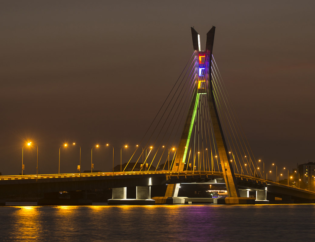
Suggested Call to Action: “If you’ve considered using prefabrication as part of your next construction project, reach out to us for guidance and a design plan to suit your needs.”
Elsatechng has an entire category built for industry trends, and each blog post focuses on one specific trend that influences how they do business. In a post on prefabrication, they discussed how they’ve used previously built or modular systems in some of their construction sites, explaining in detail the benefits of prefabrication, and how it can be used among site-built systems to complete projects on time and on budget. Another way Elsatechng Construction backs up their discussion on industry standards is to provide statistics on prefabrication use and forecast of future usage.
Prefabs and the modernist movement
Architects are incorporating modern designs into the prefabricated houses of today. Prefab housing should no longer be compared to a mobile home in terms of appearance, but to that of a complex modernist design. There has also been an increase in the use of "green" materials in the construction of these prefab houses. Consumers can easily select between different environmentally friendly finishes and wall systems. Since these homes are built in parts, it is easy for a home owner to add additional rooms or even solar panels to the roofs. Many prefab houses can be customized to the client's specific location and climate, making prefab homes much more flexible and modern than before.
Prefabricated homes were produced during the Gold Rush in the United States, when kits were produced to enable Californian prospectors to quickly construct accommodation. Homes were available in kit form by mail order in the United States in 1908.
Prefabricated housing was popular during the Second World War due to the need for mass accommodation for military personnel. The United States used Quonset huts as military buildings, and in the United Kingdom prefabricated buildings used included Nissen huts and Bellman Hangars. 'Prefabs' were built after the war as a means of quickly and cheaply providing quality housing as a replacement for the housing destroyed during the Blitz. The proliferation of prefabricated housing across the country was a result of the Burt Committee and the Housing (Temporary Accommodation) Act 1944. Under the Ministry of Works Emergency Factory Made housing programme, a specification was drawn up and bid on by various private construction and manufacturing companies. After approval by the MoW, companies could bid on Council led development schemes, resulting in whole estates of prefabs constructed to provide accommodation for those made homeless by the War and ongoing slum clearance.[9] Almost 160,000 had been built in the UK by 1948 at a cost of close to £216 million. The largest single prefab estate in Britain[10] was at Belle Vale (South Liverpool), where more than 1,100 were built after World War 2. The estate was demolished in the 1960s amid much controversy as the prefabs were very popular with residents at the time.




